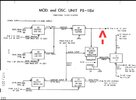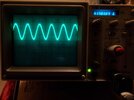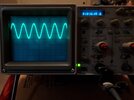I need some guidance regarding LSB on an FT-101E. It transmits and receives approximately 3.25 -3.5 khz above the given frequency. This was confirmed over the air as well as with a seperate radio nearby. USB and AM transmit and receive correctly. I can't find anything in the service manual that addresses SSB alignment specifically so I was hoping for some help. The radio has been recapped, the standard transmit/receive trimmer peaking was done, the rig has 6 VDC on the dot and the receive/clarifier/transmit are all at 3.672 VDC. Any help would be greatly appreciated. Thank you.
You are using an out of date browser. It may not display this or other websites correctly.
You should upgrade or use an alternative browser.
You should upgrade or use an alternative browser.
-
You can now help support WorldwideDX when you shop on Amazon at no additional cost to you! Simply follow this Shop on Amazon link first and a portion of any purchase is sent to WorldwideDX to help with site costs.
FT-101E LSB is off frequency
- Thread starter Champo
- Start date
BJ radionut
Supporting Member and 6m addict
The LSB Carrier Generator crystal is located on the P-1184A "MOD and OSC Unit" board. The LSB crystal frequency is 3181.5Khz.
It's possible the LSB oscillator transistor, Q5 (2SC372Y) is bad and the crystal is okay or TC3 (LSB crystal adjust cap) has been adjusted to the point the oscillator no longer oscillates.
I recommend you make sure the transistor is good and that TC3 has not been adjusted too far before replacing the LSB Carrier Generator crystal.

 forums.qrz.com
forums.qrz.com

 www.bing.com
www.bing.com
It's possible the LSB oscillator transistor, Q5 (2SC372Y) is bad and the crystal is okay or TC3 (LSB crystal adjust cap) has been adjusted to the point the oscillator no longer oscillates.
I recommend you make sure the transistor is good and that TC3 has not been adjusted too far before replacing the LSB Carrier Generator crystal.
Yaesu FT-101E works fine only NO LSB! ARRGGHH!
Greetings everyone. I have a problem with a Yaesu FT-101E that I recently purchased. This radio operates fine on all bands with full output power...
 forums.qrz.com
forums.qrz.com

ft-101 frequency LSB issues - Bing
Intelligent search from Bing makes it easier to quickly find what you’re looking for and rewards you.
Thank you very much! That was the info I needed. It is very much appreciated.The LSB Carrier Generator crystal is located on the P-1184A "MOD and OSC Unit" board. The LSB crystal frequency is 3181.5Khz.
It's possible the LSB oscillator transistor, Q5 (2SC372Y) is bad and the crystal is okay or TC3 (LSB crystal adjust cap) has been adjusted to the point the oscillator no longer oscillates.
I recommend you make sure the transistor is good and that TC3 has not been adjusted too far before replacing the LSB Carrier Generator crystal.

Yaesu FT-101E works fine only NO LSB! ARRGGHH!
Greetings everyone. I have a problem with a Yaesu FT-101E that I recently purchased. This radio operates fine on all bands with full output power...forums.qrz.com

ft-101 frequency LSB issues - Bing
Intelligent search from Bing makes it easier to quickly find what you’re looking for and rewards you.www.bing.com
Consider also that this radio does not automatically adjust the operating frequency when you change modes. The built-in calibrate carrier will show two different dial positions when you zero beat upper and then lower sideband.
The reason the outer ring of the tuning knob is on a felt slip clutch is to compensate for each band crystal's individual frequency error. The band crystals are all off from one another by a few kHz typically. Since the carrier crystal in use changes frequency when you change modes, it cause the operating frequency to shift in step.
Newer radios compensate for this, the way a FCC-legal CB radio has been required to do for decades, and stay on frequency when the mode switch is turned.
On a good day.
73
The reason the outer ring of the tuning knob is on a felt slip clutch is to compensate for each band crystal's individual frequency error. The band crystals are all off from one another by a few kHz typically. Since the carrier crystal in use changes frequency when you change modes, it cause the operating frequency to shift in step.
Newer radios compensate for this, the way a FCC-legal CB radio has been required to do for decades, and stay on frequency when the mode switch is turned.
On a good day.
73
Nomad I appreciate the information. This is more than likely what is occurring. I verified that the crystals are on their respective frequencies at pin 6 of PB1184A. 3178.3 for USB and 3181.6 for LSB.Consider also that this radio does not automatically adjust the operating frequency when you change modes. The built-in calibrate carrier will show two different dial positions when you zero beat upper and then lower sideband.
The reason the outer ring of the tuning knob is on a felt slip clutch is to compensate for each band crystal's individual frequency error. The band crystals are all off from one another by a few kHz typically. Since the carrier crystal in use changes frequency when you change modes, it cause the operating frequency to shift in step.
Newer radios compensate for this, the way a FCC-legal CB radio has been required to do for decades, and stay on frequency when the mode switch is turned.
On a good day.
73
Perhaps you can teach a new dog some old tricks regarding zero beating the rig when you switch modes. If using a YC-601 with the FT-101E, it would seem that you would need to zero beat the radio when you switch modes and then manually calibrate the YC-601 to the zero beat of the new mode. If you switch modes again repeat the same process?
Zero beating is something I've actually struggled to understand. Perhaps you can educate noob. When you activate the 25Khz or 100 Khz tone would zero be at the peak receive level on the meter? Thank you for your help.
Attachments
Ah, to start with, the presence of a "Cal" knob of the YC-601 tells you that the digital display's calibration must be set to match the band and mode in use, both. The 1 kHz marks on the ring of the tuning knob will reveal a 3 kHz difference between USB and LSB. Moving that ring to line up the 100 kHz or 25 kHz mark does the same thing as what that knob on the YC is about. Any time you change bands, or change from one mode to another, the setting of that knob is disrupted. The Cal knob gets reset to match same as the slip ring on the main tuning knob.
73
73
Nomad thank you for that. So what is the proper way to zero beat the rig if you can't hear WWV? Is it to simply peak the S-meter with the 100Khz or 25Khz markers while in the proper mode (USB, LSB or TUNE) or do you do what this guy did? One of the comments said his method is incorrect so that's why I'm asking.
Thank you as always!
Thank you as always!
Well, for starters I'm using a receiver that doesn't lose calibration when you change bands. The FT101 has to be calibrated when changing bands, modes or both.
SSB and CW modes inject a carrier into the receiver, so you'll get a tone on CW and voice audio on SSB. Without that carrier, sideband would have that donald-duck sound you hear listening in AM mode. The calibrate selector puts a carrier every 25 or 100 kHz across the dial. The idea is find the frequency where the audio tone pitch bottoms out and then rises again if you keep turning the knob. That 'zero' point where the pitch will rise whichever way you turn the tuning knob. That 'zero beat' point is what you're shooting for against the carrier from the 25 kHz/100 kHz built-in calibrator.
Finding channel frequency on AM receive this way is a whole 'nother can of worms. Typical setup decades ago was to use an inline frequency counter, or a patch cord from the transverter socket to a bench counter's input jack. Setting the radio to the desired carrier frequency got done that way. And if your radio didn't have the AM filter properly installed, you would end up 'clarifying' different AM stations with the RIT knob.
73
SSB and CW modes inject a carrier into the receiver, so you'll get a tone on CW and voice audio on SSB. Without that carrier, sideband would have that donald-duck sound you hear listening in AM mode. The calibrate selector puts a carrier every 25 or 100 kHz across the dial. The idea is find the frequency where the audio tone pitch bottoms out and then rises again if you keep turning the knob. That 'zero' point where the pitch will rise whichever way you turn the tuning knob. That 'zero beat' point is what you're shooting for against the carrier from the 25 kHz/100 kHz built-in calibrator.
Finding channel frequency on AM receive this way is a whole 'nother can of worms. Typical setup decades ago was to use an inline frequency counter, or a patch cord from the transverter socket to a bench counter's input jack. Setting the radio to the desired carrier frequency got done that way. And if your radio didn't have the AM filter properly installed, you would end up 'clarifying' different AM stations with the RIT knob.
73
Thank you for that Nomad. One last question if I could. I have a pretty substantial harmonic 210 kHz away from the transmitted frequency. Is this typical of a radio from this vintage or am I looking at an alignment issue of some sort? Initially I followed the procedure to peak the trimmers with the internal meter. That didn't change anything regarding the harmonic. I later found a procedure that uses a scope to peak the trimmers so I followed that. I'll find out if that fixed it tonight. If not though where would you start your search? Thanks!Well, for starters I'm using a receiver that doesn't lose calibration when you change bands. The FT101 has to be calibrated when changing bands, modes or both.
SSB and CW modes inject a carrier into the receiver, so you'll get a tone on CW and voice audio on SSB. Without that carrier, sideband would have that donald-duck sound you hear listening in AM mode. The calibrate selector puts a carrier every 25 or 100 kHz across the dial. The idea is find the frequency where the audio tone pitch bottoms out and then rises again if you keep turning the knob. That 'zero' point where the pitch will rise whichever way you turn the tuning knob. That 'zero beat' point is what you're shooting for against the carrier from the 25 kHz/100 kHz built-in calibrator.
Finding channel frequency on AM receive this way is a whole 'nother can of worms. Typical setup decades ago was to use an inline frequency counter, or a patch cord from the transverter socket to a bench counter's input jack. Setting the radio to the desired carrier frequency got done that way. And if your radio didn't have the AM filter properly installed, you would end up 'clarifying' different AM stations with the RIT knob.
73
dxChat
- No one is chatting at the moment.
-
@ Wildcat27:Hello I have a old school 2950 receives great on all modes and transmits great on AM but no transmit on SSB. Does anyone have any idea?
-
-
-
dxBot:63Sprint has left the room.
-
dxBot:kennyjames 0151 has left the room.



